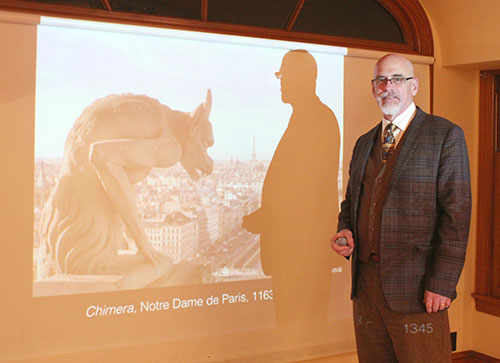
Not only do gargoyles spout water from buildings, serve as garden fixtures to scare away yard pests and pose as sculpted art, they also come with an interesting history. The words “gargoyle” and “gargle” are traced to the French word ‘gargouille,’ meaning “throat,” says Preston Metcalf, chief curator of the Triton Museum of Art, during his Feb. 25 lecture, “Gargoyles: Grotesque Protectors on High.” This lecture is one of six Metcalf is giving in February and March as part of the museum’s “Dark Curiosities of Art History” series.
“There was a man named Romanus; it was said he was born of a virgin…An angel appeared to him and prophesized he would be a great spiritual leader,” says Metcalf, sharing the French legend of the Gargouille from seventh century Europe. “There was a hideous dragon named Gargouille, a four legged winged dragon that spewed fire. One day Romanus said he’d go hunt the dragon…Asian dragons give good fortune and the European dragons hoard gold and capture virgins.”
The legend goes on to say that Romanus showed the sign of the cross to defeat the dragon. Gargouille’s head, rather scary looking, was later set on the wall of a church to keep evil spirits away.
Gargoyles figure in the history of the term “eavesdropping”, which has its roots from the days of Henry VIII, who separated the English church from Rome to get a divorce so he could marry Anne Boleyn. At the time, the Catholic Pope wouldn’t grant him the divorce he wanted.
“Someone once told me that the Church of England is the Catholic Church without the guilt,” Metcalf says. “Henry’s bride, Anne Boleyn, was hated. Inside the church, Henry would get paranoid. This was at the Great Hall inside Hampton Court Palace when people would mingle before the king came through. Here’s where gargoyles came in. Up on top where the ceiling is are little figures looking down. These figures are the grotesques. They are mounted on the inside of the palace looking down on the eaves. The message to people was ‘don’t whisper, the king is watching.’ This is where the term ‘eavesdropping’ came from. Did it work? No. Anne still lost her head.”
Visit www.tritonmuseum.org to learn more about the other lectures in the Dark Curiosities of Art History series.





